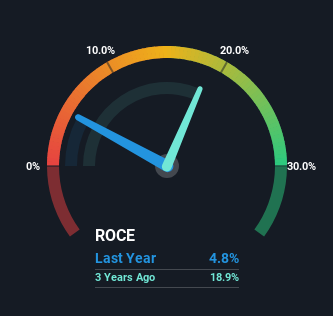- China
- /
- Gas Utilities
- /
- SZSE:000421
Nanjing Public Utilities Development (SZSE:000421) Is Reinvesting At Lower Rates Of Return
If you're looking for a multi-bagger, there's a few things to keep an eye out for. Firstly, we'll want to see a proven return on capital employed (ROCE) that is increasing, and secondly, an expanding base of capital employed. If you see this, it typically means it's a company with a great business model and plenty of profitable reinvestment opportunities. Having said that, from a first glance at Nanjing Public Utilities Development (SZSE:000421) we aren't jumping out of our chairs at how returns are trending, but let's have a deeper look.
Return On Capital Employed (ROCE): What Is It?
Just to clarify if you're unsure, ROCE is a metric for evaluating how much pre-tax income (in percentage terms) a company earns on the capital invested in its business. Analysts use this formula to calculate it for Nanjing Public Utilities Development:
Return on Capital Employed = Earnings Before Interest and Tax (EBIT) ÷ (Total Assets - Current Liabilities)
0.048 = CN¥303m ÷ (CN¥15b - CN¥9.0b) (Based on the trailing twelve months to September 2023).
Therefore, Nanjing Public Utilities Development has an ROCE of 4.8%. In absolute terms, that's a low return and it also under-performs the Gas Utilities industry average of 9.2%.
Check out our latest analysis for Nanjing Public Utilities Development

While the past is not representative of the future, it can be helpful to know how a company has performed historically, which is why we have this chart above. If you're interested in investigating Nanjing Public Utilities Development's past further, check out this free graph covering Nanjing Public Utilities Development's past earnings, revenue and cash flow.
The Trend Of ROCE
On the surface, the trend of ROCE at Nanjing Public Utilities Development doesn't inspire confidence. Over the last five years, returns on capital have decreased to 4.8% from 8.5% five years ago. Although, given both revenue and the amount of assets employed in the business have increased, it could suggest the company is investing in growth, and the extra capital has led to a short-term reduction in ROCE. If these investments prove successful, this can bode very well for long term stock performance.
Another thing to note, Nanjing Public Utilities Development has a high ratio of current liabilities to total assets of 59%. This can bring about some risks because the company is basically operating with a rather large reliance on its suppliers or other sorts of short-term creditors. While it's not necessarily a bad thing, it can be beneficial if this ratio is lower.
What We Can Learn From Nanjing Public Utilities Development's ROCE
Even though returns on capital have fallen in the short term, we find it promising that revenue and capital employed have both increased for Nanjing Public Utilities Development. These trends are starting to be recognized by investors since the stock has delivered a 9.2% gain to shareholders who've held over the last five years. Therefore we'd recommend looking further into this stock to confirm if it has the makings of a good investment.
If you want to know some of the risks facing Nanjing Public Utilities Development we've found 3 warning signs (2 shouldn't be ignored!) that you should be aware of before investing here.
If you want to search for solid companies with great earnings, check out this free list of companies with good balance sheets and impressive returns on equity.
Mobile Infrastructure for Defense and Disaster
The next wave in robotics isn't humanoid. Its fully autonomous towers delivering 5G, ISR, and radar in under 30 minutes, anywhere.
Get the investor briefing before the next round of contracts
Sponsored On Behalf of CiTechValuation is complex, but we're here to simplify it.
Discover if Nanjing Public Utilities Development might be undervalued or overvalued with our detailed analysis, featuring fair value estimates, potential risks, dividends, insider trades, and its financial condition.
Access Free AnalysisHave feedback on this article? Concerned about the content? Get in touch with us directly. Alternatively, email editorial-team (at) simplywallst.com.
This article by Simply Wall St is general in nature. We provide commentary based on historical data and analyst forecasts only using an unbiased methodology and our articles are not intended to be financial advice. It does not constitute a recommendation to buy or sell any stock, and does not take account of your objectives, or your financial situation. We aim to bring you long-term focused analysis driven by fundamental data. Note that our analysis may not factor in the latest price-sensitive company announcements or qualitative material. Simply Wall St has no position in any stocks mentioned.
About SZSE:000421
Nanjing Public Utilities Development
Nanjing Public Utilities Development Co., Ltd.
Excellent balance sheet and fair value.
Market Insights
Weekly Picks

THE KINGDOM OF BROWN GOODS: WHY MGPI IS BEING CRUSHED BY INVENTORY & PRIMED FOR RESURRECTION


Why Vertical Aerospace (NYSE: EVTL) is Worth Possibly Over 13x its Current Price


The Quiet Giant That Became AI’s Power Grid
Recently Updated Narratives

Butler National (Buks) outperforms.


A tech powerhouse quietly powering the world’s AI infrastructure.


Keppel DC REIT (SGX: AJBU) is a resilient gem in the data center space.
Popular Narratives


MicroVision will explode future revenue by 380.37% with a vision towards success


Crazy Undervalued 42 Baggers Silver Play (Active & Running Mine)





